FELINE MEDICAL CURIOSITIES: THE LIMBS
Note: Contrary to suggestions on some bulletin boards, the images here are not photoshop. With the exception of those labelled as artist's impressions these are photos of medical conditions. This page is intended as a medical reference. Offsite links to images on these pages is not supported - bandwidth costs money!
KANGAROO CATS AND TWISTY CATS
A full article on the various types and causes of missing or short front legs can be found at Kangaroo CatsPARTIAL LIMBS
Kathey's cat, Hobie, was born with 3 1/2 legs. His front right leg ends in one hook shaped claw. In 2007, Hobie was 5 years old - a huge and very long cat given a clean bill of health by the vet. Kathey got Hobie when he was 6 weeks old. He manages well on 3 1/2 legs and his hind quarters are more developed and muscular than his fore quarters. Though affectionate and playful, he is less active than many other cats and tends to gain weight because he is not as active as other cats (and also somewhat spoiled!).
Tabby Worthington rescued a stray cat that had 4 kittens (2 survived) on 4th July 2010. One of the 2 survivors had deformed forelimb, but was vigourous and thrived. Kittens knead around the nipple to stimulate milk flow and even with one foreshortened limb, this kitten was able to suckle well. Being one of only 2 kittens meant less competition for nipples which increased its chances. Cats can manage well on only 3 limbs.
TWISTED HIND LIMBS
A full article on kittens born with twisted hind limbs and how to treat the condition can be found at Twisted Limbs in Kittens
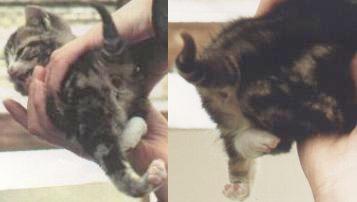
This appears to be a birth defect (developmental abnormality) where the limbs become twisted in the womb. The hindlimbs are twisted backwards, the joints may be reversed and the bones themselves may be bowed. In some cases, the condition can be corrected by splinting and exercise.
In severe cases the deformity affects the whole of the rear part of the animal. The kitten pictured was one of two kittens taken into Chelmsford Cats Protection shelter. The other kitten was completely normal. It was approximately 6 weeks old when photographed.
Both back paws were twisted backwards; one is also twisted sideways. Though the legs could be moved, they were weak and uncoordinated. The skin had become ulcerated where the kitten was dragging itself along. The kitten's tail was short, no bigger than that of a newborn, and poorly developed. The lower bowel was also affected and produced jelly-like faeces.
The veterinarian attempted to correct the deformity using splints to re-set the legs, but this was not successful. Because the kitten had other health problems which would most likely have caused premature death, it was euthanized. The kitten shown was born to a stray so it is tempting to blame the condition on poor diet or poor conditions. However, twisted legs have also been reported in pedigree cats' litters where the cats receive excellent care. Usually it is due to cramped conditions in the womb forcing the legs into an unusual position; if caught early it can be corrected with physiotherapy, massage and splinting the leg(s) into to the correct position.
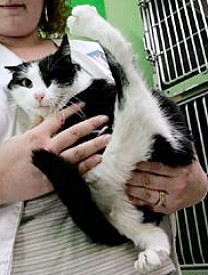
Baby Girl, a five-legged stray from Cannonsburg, Pennsylvania has a superfluous paw growing from the left side of her body and a deformed left hind leg. She already moves well on three good legs, so a vet will remove the deformed leg and the extra paw. The vets claim the deformities are due to inbreeding, but it is more likely to be a non-inherited congenital abnormality. The deformed hindleg might be due to the leg being stuck in an awkward position in a crowded womb; if not treated at birth (splinting and massage) the leg becomes fixed in the abnormal position.
EXTRA FORELEGS
|
Australian female cat from the late 1800s/early 1900s with short forelegs. Possibly the first documented short-legged cat. If you look at the thick foreleg nearest the camera there are signs of duplicated bone structure within the leg, but these did not separate to give a duplicated foreleg. |
In March 2005, I received reports and images of a six-legged cat in the USA. The adult male bicolour stray had a duplicated foreleg on its left side and a a vestigial paw, comprising toes only, attached above the usual paw of its right side. X-rays indicated that the right foreleg contained additional bones showing that the vestigial paw was part of a duplicated foreleg and was not a polydactyl thumb. The left duplicate foreleg was positioned above the normal foreleg and though complete did not appear to be under voluntary control (i.e. could not be moved independently of the normal foreleg but did appear to mirror some of the normal leg's back and forth movement, probably due to muscle attachments at the shoulder blade). At rest, the duplicate foreleg pointed foreward, horizontal with the shoulder. Because a largely inert duplicate leg would pose a hazard to an active cat (it could easily become caught if the cat climbed), veterinarians planned to amputate it. This cat also had three testicles. The duplication of forelimbs could be due to conjoined twinning or due to disruption of development of the limb bud resulting in duplicate limb buds.
|
|
In April 2006, a 6-legged ginger tabby called Willoughby was being cared for at the private Hervey Foundation for Cats shelter in Edmonton, Canada. Shelter founder and president Marjorie Hervey collected Willoughby from Edmonton's Animal Control dept after he was found straying in a south Edmonton neighborhood. Although he appears to be a well cared for pet, no-one collected the distinctive cat during his week with Animal Control. At an estimated age of 1 year, the cat has 4 front legs. On one side, the two front legs are fused together from shoulder to paw. On the other side, the 2 front limbs are much shorter and will probably be amputated as the cat can move them, but not walk on them. The cat mainly walks using the fused forelegs of the other side. Surgery is expected to cost $2000.
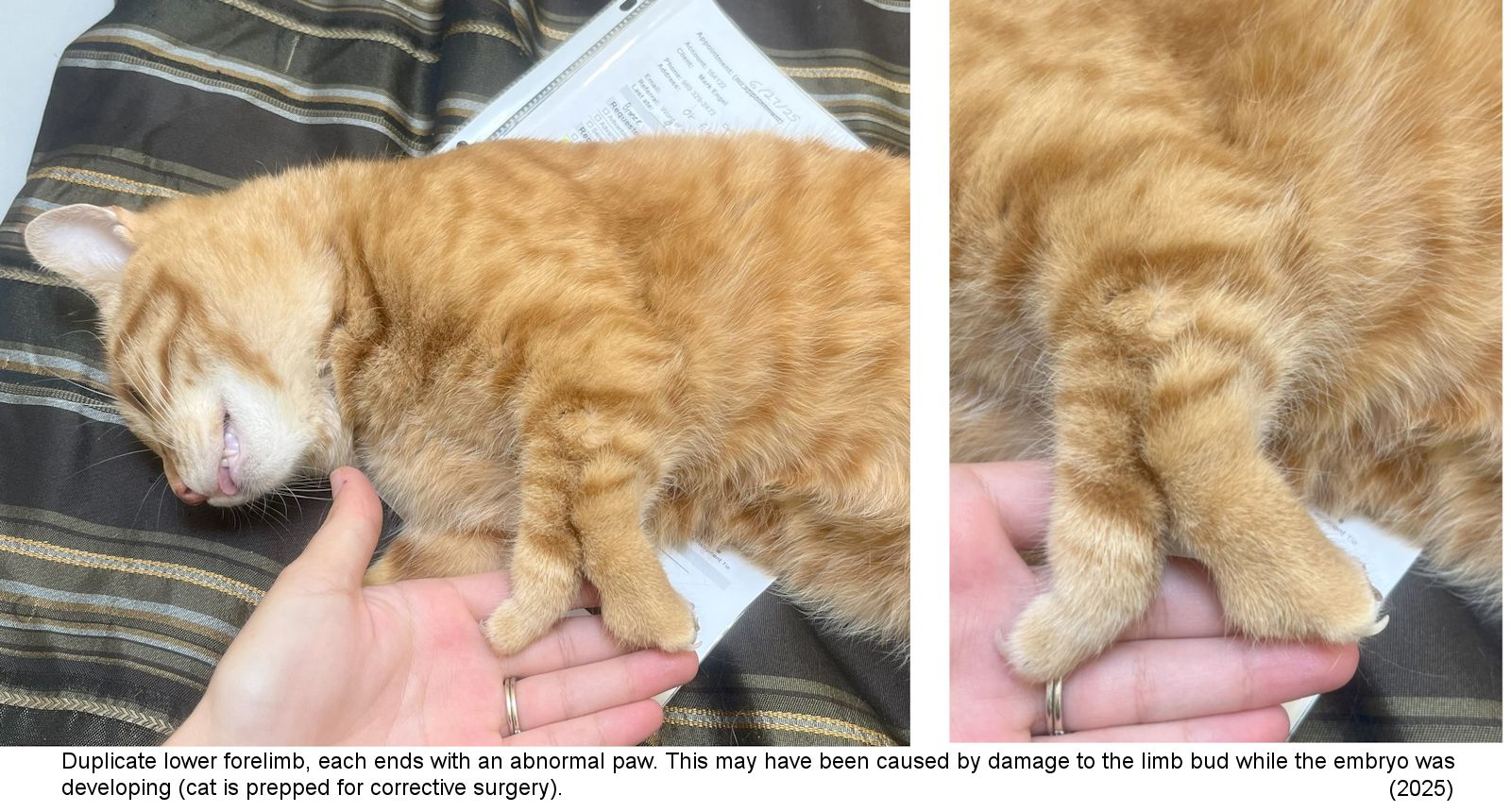
EXTRA HINDLEGS
Most reports of extra hind-limbs relate to incomplete conjoined twinning. There are occasional reports of cats with single vestigial hind-legs. In August 2008, a case was reported where the supernumery limb was a vestigial leg, complete with paw and claws but non-functioning, located on the back about 3 inches from the tail.
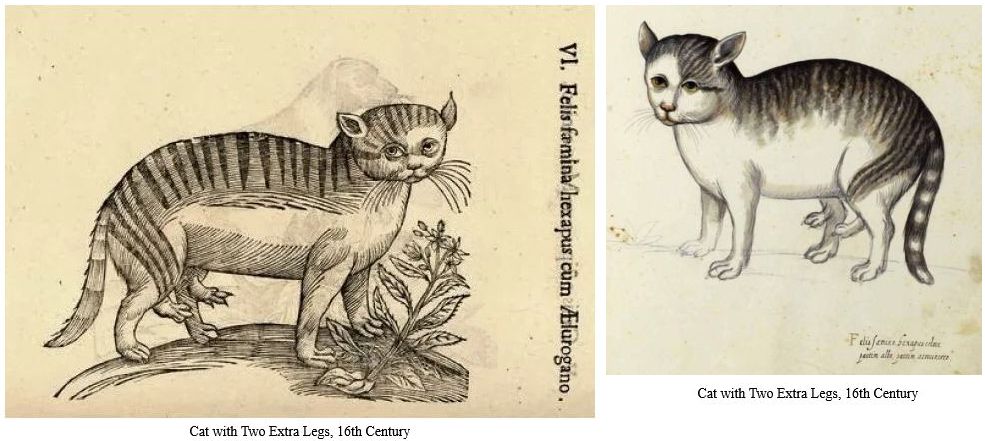
MUMMIFICATION OF THE LEG/ACCIDENTAL PART-AMPUTATION OF LEG
Twinkle, a calico female, got her front paw caught in an animal trap. Cats cope well with only 3 legs and normally the whole of the damaged leg is removed, but Twinkle already had only 3 functioning legs because one of her hind legs was mummified.
The photo shows Twinkle after partial removal of her front paw (which was too badly damaged to be saved).
The close-ups(below) of the mummified hind leg show how the skin and flesh have dried up and turned into a hard, almost bony material (probably keratin or compressed hair like a rhino horn). Some tufts of fur remain clinging to the mummified paw pad and the white bones of the toes are actually visible through the hardened material.
|
|
|
The mummified leg felt light and frighteningly fragile as though it was going to snap whenever the cat put weight on it. No-one was sure why the leg mummified or when it had happened (Twinkle was a stray) or how the cat had survived without blood poisoning (and more surprisingly, Twinkle gave birth a few weeks later). It might have happened recently since there were scraps of fur on what remained of the paw. The place where mummified flesh met normal flesh was a particular concern (danger of infection) and several weeks later, the mummified leg had to be amputated completely.
|
|
|
|
Demonstrating the cat's ability to survive injury, this feral (wild) cat broke her leg at the ankle joint. The paw has twisted around and healed in a twisted position. It is amazing that the cat survived long enough, fending for herself, for the leg to heal albeit in an abnormal position. This type of foreleg injury is common where there are large metal dustbins with heavy lids - there are many cats in Mediterranean areas suffer crushed or severed paws when the lid traps their foreleg. The point where the leg was broken has formed a callus. The lower leg has set at 90 degrees to the rest of the leg, with the paw twisted right round. Had the cat been a domestic pet, the injured paw would have been set or the leg would have been amputated. As a feral, she had to cope as best she could. Some feral cats have even survived accidental amputation of a leg which got caught in farm machinery.
ABSENT HIND LIMBS
One of the first accounts of a cat that lacked hindlegs comes from The New York Times of November 14, 1871 in an article entitled "Cats and Their Owners - The Proud Status of Cats in New-York - Some Remarkable Cats - A Curious Cat Fancier and Her Home: AHRENS, on Broadway and Seventeenth-street, has in his saloon a lively tabby cat, which was born with only two legs. Its hind legs are wanting, and the extremity of its body is something like that of a wasp, with the addition of a short, broad tail, which looks like the rudder to a vessel. its method of locomotion is peculiar. If it wants to go a considerable distance it hops like a kangaroo; if it has only a few feet to traverse it wriggles along on its extremity, helping itself with its forelegs, something like a baby with weak loins sometimes contrives to crawl. It has a capital appetite and enjoys very good health.

Stumpy (above) has no hind legs. One hind leg ends in a callus at the hock joint; the other ends below the knee. One leg, the knee bent the opposite way to normal and had to be removed, leaving Stumpy with only half a back leg. Despite this, she gets around by hopping on her two and a bit legs.
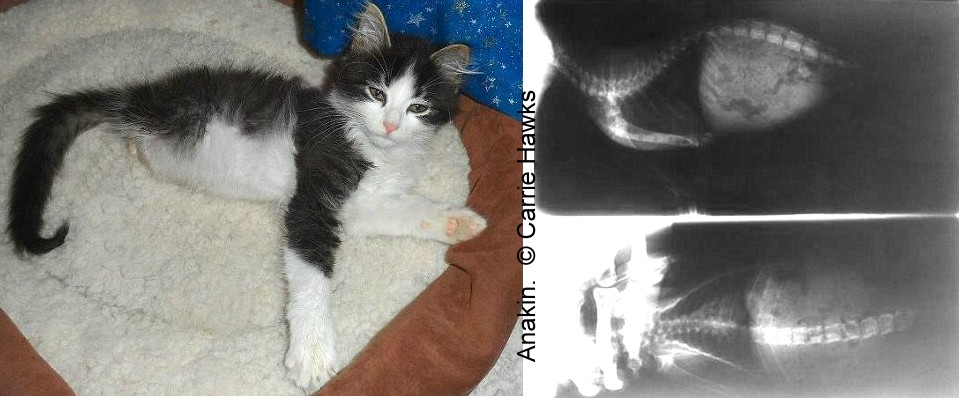
In 2012, Carrie Hawks (Florida, USA) found a male kitten that had been born without a pelvis or his two hind legs. This kitten had apparently been wandering in the woods with a group of feral cats. She caught the disabled kitten and named him Anakin. At 2 3 months old, he plays and scurries around by balancing on his forelegs, which he positions under his middle, and balancing with his tail. X-rays showed that despite missing his pelvis and hind limbs, he is otherwise normal with no internal abnormalities, although he sometimes needs enemas as he can t always expel faeces (especially as he can t squat normally). Should Anakin start to find things difficult, he will be fitted with a cat-wheelchair to support his hind end.
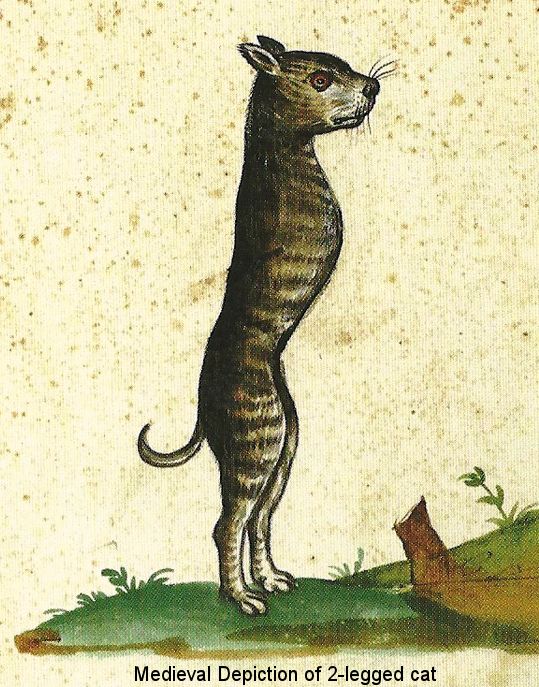
MORE ANOMALIES
If you have come to this page directly from a search engine, please check out
FELINE MEDICAL CURIOSITIES for the full index of topics includingBOOKS ABOUT ANOMALIES
If you are interested in medical curiosities, books worth reading are "Mutants: on the Form, Varieties and Errors of the Human Body" by Armand Marie Leroi and "Anomalies and Curiosities of Medicine Vols 1 and 2" by George M. Gould & Walter L. Pyle. The Gould & Pyle books were published in 1896 and are in the public domain. You can download text-only versions of Gould & Pyle from several websites so don't waste money on text-only versions of the book; but if you want the versions with photos, consider the Kessinger editions. The Leroi book explains why and how some deformities and anomalies happen - the mechanism is the same in cats as it is in humans.
You are visitor number